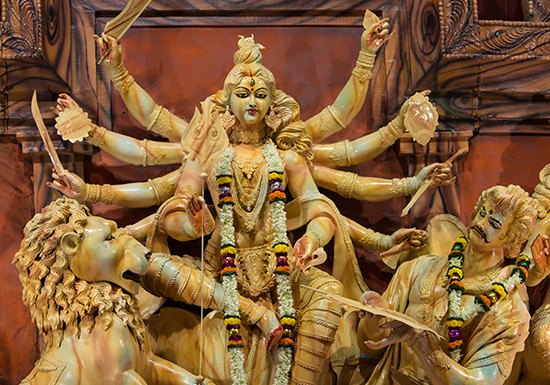Vijaya means ‘victory,’ and ‘dashami’ means ‘10th day’.
Vijayadashami, or Dussehra, is the 10th day of the Durga Pooja festival, which honors the Divine Mother or Supreme Goddess. It is also the final day of the festival. This year it was on October 5. Hindus celebrate this day in different ways.
Some commemorate it as the day Goddess Durga killed the demon Mahishasura. The festival is also called Navratri. After nine days of worshipping nine forms of the Goddess, the festival ends with the immersion of the idol of Durga on the day of Vijayadashami.
In other regions, people celebrate this day to mark the victory of Lord Rama, an avatar of Vishnu, over the demon Ravana. Giant effigies of Ravana are set on fire to symbolize the destruction of evil.
The festival has many names - Dasha-Hara or Dussehra in the north, Vijayadashami in the south, and Durgotsav or Durga Pooja in the east. Whatever the name, the message of the festival is the same - good prevails over evil.
Vijayadashami falls on the 10th day of the waxing moon phase in Ashwin month. This day is also called Madhwa Jayanthi day or the day Lord Vayu (Wind God) took birth as Sri Madhwacharya. Shirdi Sai Baba Mahasamadhi also falls on this day.
In the south, the festival is also known as Saraswati Pooja. Saraswati is the Goddess of knowledge. People worship her on this day, along with their tools and instruments.
Vijayadashami in Myths
Lord Rama and Ravana
Lord Vishnu incarnated as Rama, the son of King Dasharatha of Ayodhya, during the Treta Yuga. Rama was the 7th incarnation of Vishnu. Due to a boon that his father had given to Rama’s stepmother, Kaikeyi, Rama had to go into exile for 14 years. Sita, his wife, and brother Lakshmana also accompanied him. During their exile, the demon king of Lanka, the 10-headed Ravana, kidnapped Sita and took her to Lanka. Rama, with the help of the Vanarasena led by Sugriva and Hanuman, went to Lanka and waged war to recover Sita.
During the battle, Rama killed Ravana. The day he killed Ravana is celebrated as Vijayadashami. Devotees celebrate it by burning the huge effigies of Ravana, Kumbhakarna (brother of Ravana), and Meghnad (son of Ravana). They also stage plays (Ramlila) based on Rama’s life.
Durga and Mahishasura
According to another legend, Goddess Durga killed the buffalo-headed demon, Mahishasura, on this day. Mahishasura was causing trouble in the 3 worlds after getting a boon that made him invincible. Goddess Shakti took the form of Durga to restore Dharma. She fought Mahisha and many other demons for nine days. On the tenth day, Mahisha was killed. This day came to be celebrated as Vijayadashami.
Arjuna and his weapons
From the Mahabharata comes another story about this festival.
In the final year of their exile, the Pandavas had to live incognito. So Arjuna hid his weapons, many of which were divine, high up in a Khijdo tree. The Pandavas were working for the king of Viratnagar, who was unaware of their true identities. Arjuna worked as a female dance teacher, Brihannala. One day, the Kauravas stole the king’s horses. As the king was not in the kingdom, the young and inexperienced Prince Uttar decided to confront the Kauravas. Arjuna, as Brihannala, volunteered to assist him. Arjuna then went to the Khijdo tree and retrieved his weapons. He also cleaned the weapons and did a Pooja for them, as most of them had been given to him by the gods. During the fight with the Kauravas, Arjuna put them to sleep with a single arrow, as he did not want to harm his elders and cousins. This arrow was the Sammohan Astra. Another name for Arjuna was Vijaya meaning ‘one who is always victorious’. Thus, to celebrate Arjuna’s victory, the day came to be called Vijayadashami.
How is Vijayadashami celebrated?
Dussehra is an auspicious day to start new ventures or make new investments. People also immerse the idols of Durga in water bodies on this day in a ceremonial farewell, as the Goddess returns to her heavenly abode.
In north India, effigies of Ravana, Meghanad, and Kumbhakarna are set alight with a flaming arrow. Episodes from the Ramayana are enacted. This is called Ram Leela. In the Kullu valley of Himachal Pradesh, there are fairs and parades.
In Gujarat, Maharashtra, and West Bengal, people observe fast and worship at temples. Dances and folk songs are common. Devotees perform regional dances like the garba, dandiya raas, and dhunachi during the 9 nights of the festival.
In Karnataka, there are royal processions with caparisoned elephants. Temples and major forts are illuminated as well. In Tamil Nadu, people display dolls and figurines called golu or bommai golu. In Kerala, children are initiated into the world of letters.




.png)

0 Comments